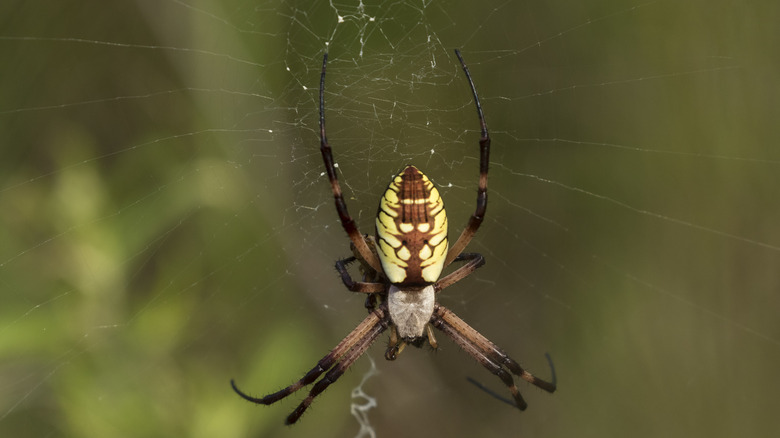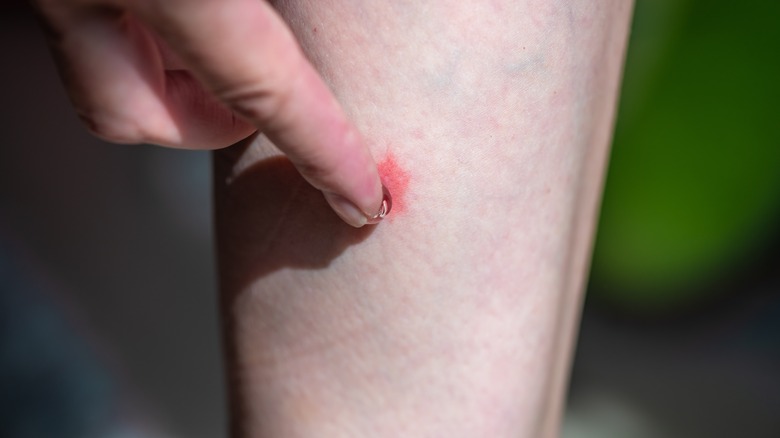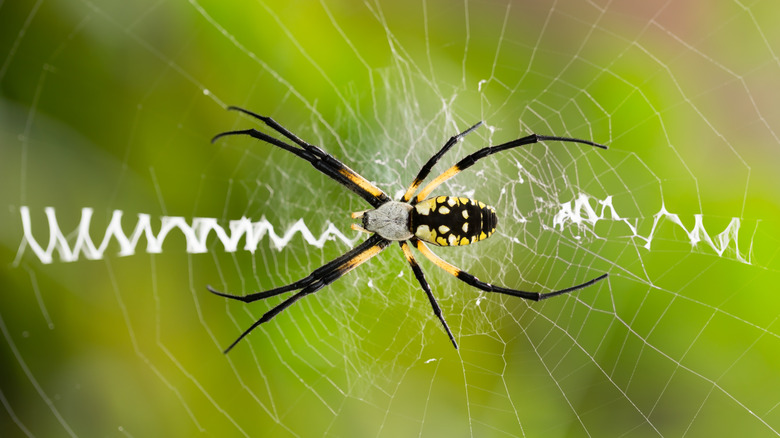Are Yellow Garden Spiders Poisonous To You Or Your Pets? Here's What To Know
A sprinkle of yellow in the fall garden would be welcoming to most gardeners. It could harken the late flush of sunflowers, the blonde overcoat of quaking aspens at the season's cusp, or reflect off the plumage of goldfinches — clearly, planting all those beautiful shrubs to attract more songbirds bore fruit. But sometimes, what the eyes gaze at isn't a songster but an eight-eyed yellow garden spider (Argiope aurantia). The black and yellow-mottled female garden spiders look especially fetching, given their brighter hues, and no, it isn't limited to their counterparts' opinion, as home gardeners tend to feel the same way too (if their arachnophobia hasn't kicked in).
That being said, should you allow the yellow garden spiders to enjoy pretty privileges in your yard? Probably, since they aren't known to send humans or their furry companions to the hospital, unlike the much-feared (rightfully!) black widow or brown recluse spiders. Garden spiders aren't usually looking to pick a fight, making them safe to be around. Rather, you're more likely to appreciate their presence, given how they gobble up nuisance pests bothering your plant friends, such as aphids, gnats, lizards, and flies.
Yellow garden spiders are venomous, but they aren't pulling any webs at you
Like most of their ilk, yellow garden spiders come armed with venom, potent enough to paralyze and liquefy insects. Fortunately, when it comes to furry pets and their humans, the size difference surely helps, and their venom has more sting than poison. What's more, they prefer dropping down to hide and relocate to a taller pasture where they're unlikely to be disturbed than respond to a trespassing (per them) human.
However, if you deliberately mess with them, aka misguidedly step on their teeny bodies or squish the poor-sighted creatures against your skin, they will bite. You'll be inconvenienced a little — a "bee sting" level of discomfort, but nothing major. Washing the area with soap, using antihistamine ointment, and applying ice compressions will allay the pain. Actively procreating female spiders are the biggest offenders for this behavior during the fall as they try to protect the eggs attached to their cobwebs.
However, people and pets with inherent allergies to spider bites need to be more careful. Their skin is likely to break out in red rashes, and their bodies may react with troubled breathing or abdominal pain (in humans) or show irritation and swelling (in dogs), even though it won't be immediately obvious. If you belong to this group or think you possibly could, steer clear of the yellow garden spiders and seek medical assistance if bitten.
Relocate yellow garden spiders if their webs pose trouble
As mentioned, yellow garden spiders are considered beneficial insects and should be left alone in the yard to guide the food chain and maintain a healthy ecosystem. However, they can become troublesome if they weave their large, intricate webs right in your face, depriving you of recreational space and preventing you from pulling out important weeds in late summer or early fall. Also known as writing spiders due to their penchant for knitting elaborate zig-zag designs, "lightning bolt" style (they can measure two feet wide!), yellow garden spiders can block access to high-traffic areas, especially right along lofty shrubbery, barns, pathways, and porches.
Under such circumstances, rather than getting rid of the spiders altogether, consider collecting and moving them elsewhere. To minimize all risks of a random bite, don gloves before taking action and trap them in a container before releasing them in an out-and-out location. Otherwise, destroy the web with a broom when the spider isn't lounging in it to send the message that its services aren't required anymore. Wasps, birds, and flies will take care of most of the spider's dormant hatchlings in the winter, keeping your yard's arachnid population in check.


